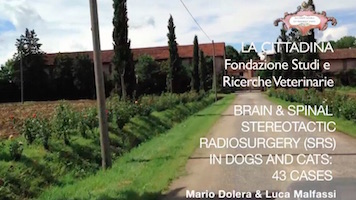BRAIN AND SPINAL STEREOTACTIC RADIOSURGERY AND HYPOFRACTIONATED RADIOTHERAPY: 43 CASES
Introduction
Stereotactic radiosurgery and hypofractionated stereotactic radiotherapy (HSRT) are advanced methods of treatment of tumors. The purpose of this study was to evaluate the feasibility and efficacy SRS and HSRT in brain and spinal neoplastic disease in dogs and cats.
Materials and methods
43 animals (37 dogs, 5 cats) with presumptive or histologically confirmed cancer of nervous system wew considered. In 35 cases, radiosurgery was curative, in 8 post-surgical adjuvant. The treatment plans were Volumetric Arc Therapy (VMAT), computed by Monaco, provided by LINAC 6 MeV with MMLC 4 mm and evaluated by DosimetryCheck both in air and in transit. Each animal was placed in a stereotactic cradle under sedation or general anesthesia; correct positioning was evaluated by cone beam CT. Controls were performed with serial clinical and MRI examination.
Results
All patients (19 meningiomas, 12 gliomas, 8 nerve sheath tumors, 4 pituitary tumors) completed the therapy. The doses delivered ranging from 16 Gy in 1 fraction to 33 Gy in 5 fractions delivered to isodose 90% of planning target volume. The RTOG showed 0 G3, 2 G2, 4 G1, 37 G0. The 6 months RECIST efficacy showed 19 partial response, 16 complete response, 7 stable disease, 1 disease progression.
Discussion/Conclusions
In 42/43 patients (97%) a control of disease was obtained. The toxic effects were quite content. The efficacy is comparable or superior to that obtainable with other fractionation schedule. SRS and HSRT are safe and effective in the control of nervous system tumors in dogs and cats.
